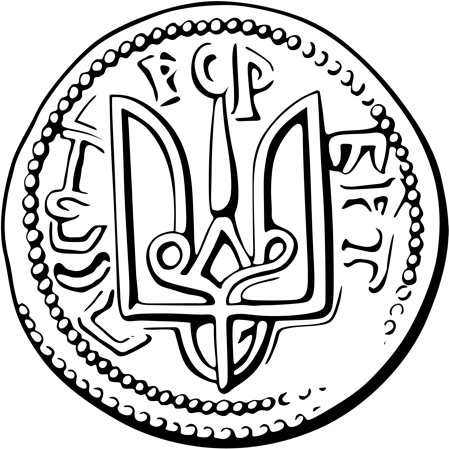Patriotic Motifs
Патріотичні мотиви
Patriotic Motifs
Патріотичні мотиви

In times of political upset, Ukrainian pysanky have reflected such changes through the motifs depicted. During periods of national independence movements in the early 20th century, tridents were frequently depicted on pysanky; this can be seen in the work of Iryna Bilianska, whose pysanky are housed in the Ukrainian Museum of New York. The same happened after Ukrainian independence in 1992; tridents and Ukrainian flags were depicted on pysanky, particularly those sold at Hutsul Easter markets.
With the beginning of the full-scale Russian invasion in 2022, patriotic motifs are once again being written on pysanky. These include tridents, the a rooster of Vasylkiv majolica, tractors (pulling armored vehicles), and patriotic inscriptions like "Oh in the meadow", "For the freedom of Ukraine", "I believe in Ukrainian Armed Forces", etc.
Below are brief descriptions of many Patriotic motifs and symbols. For more detailed information and examples of pysanky with these motifs, go to the corresponding pages in the Patriotic Motifs Gallery.
TRYZUB (TRIDENT)
As a state emblem the trident dates back to Kyivan Rus, when it was the coat of arms of the Riurykide dynasty. There are various theories about its origins and meaning. A trident was the symbol of Poseidon, the sea god of Greek mythology. It has been found in different societies, and has been used in various ways: as a religious and military emblem, a heraldic symbol, a state emblem, a monogram, and simply a decorative ornament.
The oldest examples of the trident discovered by archeologists on Ukrainian territory date back to the 1st century AD. At that time the trident probably served as a symbol of power in one of the tribes that later became part of the Ukrainian people. The trident was stamped on the gold and silver coins issued by Prince Volodymyr the Great (980–1015), who perhaps inherited the symbol from his ancestors. Although the trident continued to be used by some ruling families as a dynastic coat of arms until the 15th century, it was replaced as a state emblem in the 12th century with Saint Michael the Archangel. The trident was also used as a religious symbol in Ukrainian folklore and church heraldry.
The trident appeared not only on coins but also on the bricks of the Church of the Tithes in Kyiv (986–96), the tiles of the Dormition Cathedral in Volodymyr (1160), and the stones of other churches, castles, and palaces. It was also used as a decorative element on ceramics, weapons, rings, medallions, seals, and manuscripts. Because of its wide use in Kyivan Rus the trident evolved in many directions without losing its basic structure. Some of the variations include the bident, the trident with a cross on one of the arms or at the side, and the trident with a half-moon. Almost 200 medieval variations on the trident have been discovered.
At Mykhailo Hrushevsky’s recommendation the trident as the coat of arms of the Ukrainian National Republic in 1918. By that act the UNR leaders linked the modern Ukrainian state with the medieval state of Kyivan Rus.
On 19 February 1992, after the restoration of Ukraine's independence in 1991, the Supreme Council of Ukraine accepted the trident as the chief element in the state coat of arms.
Back to MAIN Symbolism home page.
Back to MAIN Pysanka home page.
Back to Pysanka Index.
Search my site with Google
